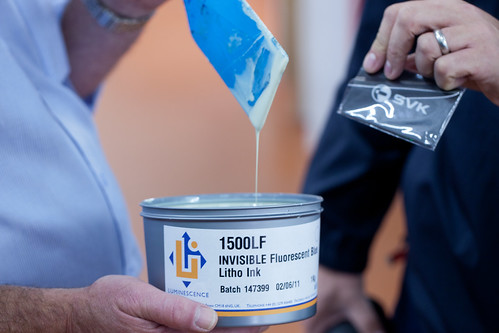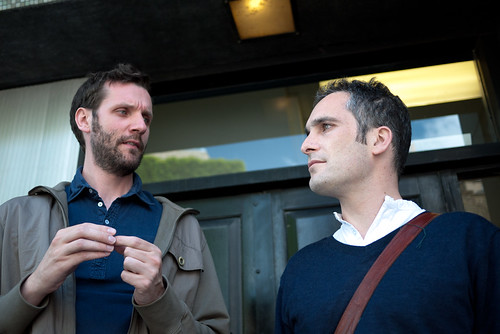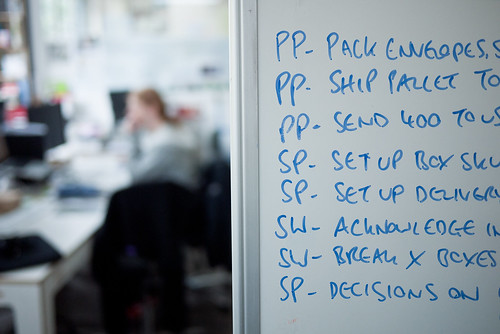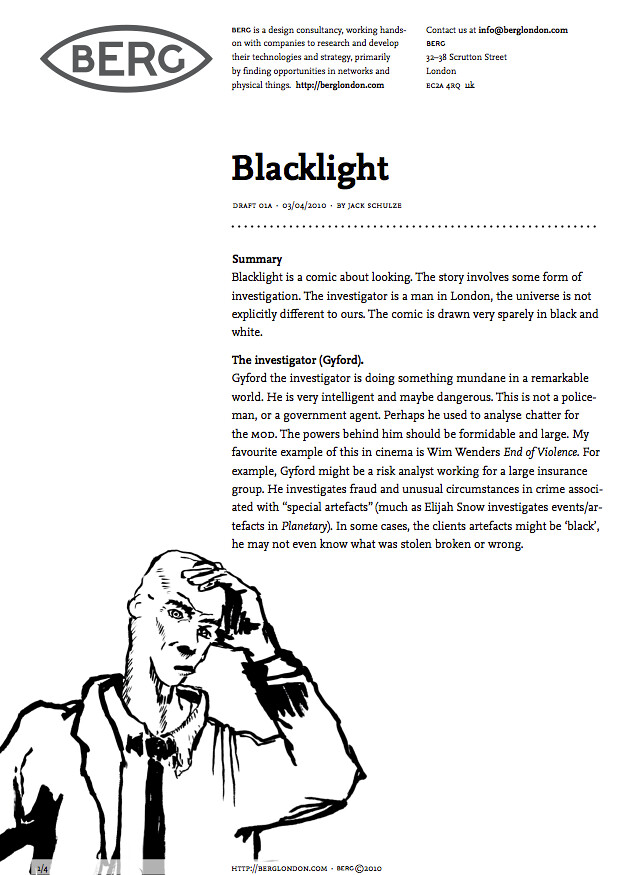In July, on the day that we first published SVK, I sat down with Jack and Matt to talk through the ideas behind the project – both in terms of the storytelling and the business challenges of bringing it into the world.

This week we released the second print run of SVK, so I thought I’d share it on the blog.

Jack Schulze: I’d been reading comics a lot, they’re some of the most sophisticated graphic output I’ve been exposed to.
I was following the work of Warren [Ellis] and Grant Morrison very closely. I found something in common between them — in some of the stories they were writing they were folding the form of the comic back into the material of the story, so that the comic was sort-of self-aware.
Specifically I’m thinking of Warren’s ‘Planetary’/’Batman’ crossover, where there are different Batmen from the various eras brought into it – from Adam West’s TV Batman to tougher modern versions, perhaps drawn from Ennis or Frank Miller. The whole thing only works because there are 80 years of ‘Batman’ comics to draw on.
More recently I was impressed with the storytelling structure of Warren’s ‘Aetheric Mechanics’. Also, Grant Morrison’s ‘The Filth’, where at some points the characters interact with the gutters and borders of the comic page. And – all this against the background of my continuing obsession for Garth Ennis’ interpretation of ‘The Punisher’.
This is brave work — in terms of the broadest sense of graphic design. I started to think about how we might make a comic with those qualities. Of course, not being comics writers or artists, we came up with a loose idea about what we could do with the technologies of ink and printing to build a story which was about looking. We wanted to see how we could use the fabric of printing and fold that back into the narrative. Looking is a preoccupation of the studio going back to projects like Glancing by Matt Webb, through to the Here & There Maps of Manhattan.
Matt Jones: you wrote an outline proposal, with the project name ‘Blacklight”, in the spring of last year – 2010?
JS: Yeah. Once I realised with Matthew that it would be possible, and he could shape it into something we could formally include in the work of the company, I had to write it down and find a way to get it made!
MJ: So, in terms of that moment of thinking about it as a product, what was your thought process? As I remember, there was a distinct moment when it tipped into reality, and you said “we could do this…”
JS: Well, there are always a lot of ideas like that floating around the studio and that was one I’d been quite, sort of, bullish on and I think that it was something that we’d discussed for quite some years. At least I think you [nods at Matt Webb] had been aware of it — and when I brought it back to you, it was because I thought I’d found a way of making it. Not anything to do with money, just literally making it — getting it written and drawn… I think you saw something in it where it had the right sort of characteristics to fit a pipeline of work that we needed in order to get it somewhere…
Matt Webb: Yes. I think the job of the studio is to bring our own ideas to life – that it’s something inventive, hopefully something that has some cultural importance – but mainly to have fun, make stuff y’know? When you can make that kind of thing achievable, when it gets some kind of independence from the client work so you can do it yourself, that’s really interesting.
There was a realisation that it [SVK] could be a kind-of ‘crystal’ business in its own right. That it could be made to work through advertising, cover-price, direct sales, working with really awesome people. There’s something about the project – I mean, independent from the fact that Warren and Matt Brooker have made a really good story… that’s also … I don’t know… it sort of commoditises the tools of business in a funny sort of way — that those tools are at the service of creative works instead of the other way around.
JS: I think to expand on that, there was something that the map had taught us — that Matthew had found a way of allowing us to make anything we wanted — as long as it would pay for itself. And that’s the kind of objective, other than the cultural impact, that the project sort of builds its own infrastructure around it, and that it doesn’t cost us anything to do so, and maybe makes a small profit.

MJ: so it’s sort of a ratchet-effect thing — a system that could be used on other products?
MW: The system we have is putting physical things into people’s hands — with all that implies — warehousing, taking money, customer support…which is something that loads of other businesses have, big ones and small ones, but for us it’s completely new and it’s an investment, so this [SVK] is an excuse for us to make that investment
MJ: Jack, what’s your recollection of approaching Warren about SVK?
JS: Well, we’d written the proposal and Matthew had written a structure of how cashflows and process could be described to make it possible and satisfying to everyone taking part. And the proposal was a combination of early thoughts — some of them very detailed and some of them much larger themes. It’s located in London, the idea of ‘looking’ being an important component, but apart from that we weren’t very precious. A lot of the remainder was up for grabs. After that, I think we just took Warren to the pub and poured beer on him until he agreed. [laughs] Beer-boarding!
MJ: Ah. [laughs] I had that recollection as well – I thought you might have more details!
JS: No! I think that was it! But I think also there was something that caught his imagination — which was that you could take the tropes of AR, Augmented reality… and do them in ink. That you were, y’know, augmenting the page. That you have a scene that has a reality common to everyone, and then a special perspective unique to a particular tool. It’s obviously not the same as augmented reality but it has a sufficient number of parallels to feel part of the same aesthetic.
MJ: Yeah, it feels for instance like the things Jamais [Cascio] is talking about in his essay in the book, the subjective realities that people will start to have through technology…
JS: Yeah and I think AR is something, as Bruce Sterling and Kevin Slavin demonstrate, that people like talking about despite its limited arrival in our hands — so I think in that respect it struck a note with Warren.
MJ: What’s struck both of you most about the process?
JS: I was amazed that from that proposal, and one meeting with Warren and Matt Brooker their communications and process was *so* well-oiled. That they basically just went and did it. In contrast to most of our projects into new territories that involve endless meetings and workshops, figuring out new processes… and although it was delayed by illnesses and various stuff… that the actual creative process — of making a narrative — was extraordinarily fluent. And I’m sure that was to do with Matt [Brooker] & Warren — I’m sure it’s not the same with every comic. And just to see in the result how much of the core important elements of the original concept have remained in, despite the fact there’s now an entire universe and story, I just found it very satisfying to work with someone with that level of trust…
MW: There was something amazing about how Warren took on the concept and almost reestablished it and made it his own. It’s an idea that could have very easily have become gimmicky, or be used just to look cool. But for it to have taken on so much of the core of the story — and it’s a cracking story — that was quite amazing. I don’t know how Warren does that.
JS: It succeeds as a comic in it’s own right — without the UV layer completing it…
MJ: you might have just answered my final question — what do you think of the finished product?
JS: I think it’s great! I’m really, really proud of it. It’s better than I could have hoped when I was imagining what it could be before it was written and drawn. And it’s just fun to see Warren’s process from the inside and have something that satisfying emerge at the end of it. I think it’s awesome.
MW: There’s something interesting about being a design studio and not being responsible for the… creative surface of what comes out…
JS: Yeah, that’s one of the core components… It’s been really interesting. It has been a true collaboration in that sense, in that the combination of figuring out the processes and the experience of the product, and having the early idea — that tangle of ideas happening with someone outside the studio. It didn’t seem like what I would understand to be a typical work-for-hire relationship. It seemed like everyone involved had their heart in it, and invested themselves in the project. I thought that was great.
SVK is available only online from http://getsvk.com


One Comment or Trackback
1. Cait said on 22 September 2011...
I was thinking about the way kids read books, after reading SVK. The whole Spy element to the thing – the SVK ‘torch’. My five year old boy thought the torch was fantastic. I had to nick it back from him.
The torch, as in the light emitted, is also a core part of a very familiar kids toy, which has evolved somewhat in recent years: the invisible ink pen. Invisible ink at one end, wee light at the other. Bolt that excitement and fun, of writing your own messages, keeping them secret from prying (parental) eyes, to the experience of reading under the sheets with a traditional torch… there’s a beautiful thought there about an incredibly immersive reading experience for kids, revealing secrets that their parents would never see if they happened to pick the book up, and the book itself being really best read under the duvet in the dark. Makes me think of the ‘surface’ of the book being somewhat tunnellish.
And sadly, Mr Jones, I don’t have the time (or writing talent at quite Warren’s standard) to publish one myself. Lazy publishing web, where are you?